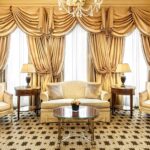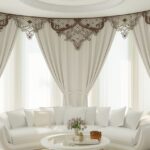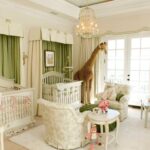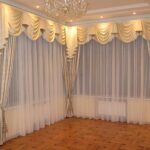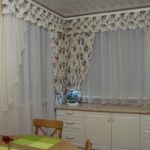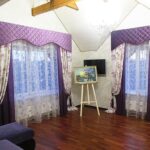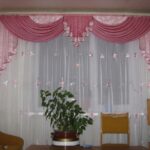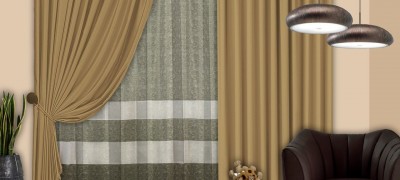The use and selection of lambrequins in the interior of the room
Lambrequin is a decorative element that adorns the upper part of the window opening. Unlike curtains, this detail is located horizontally in the upper part of the window or tightly to the ceiling, along the entire width of the window or wall, and does not hang down vertically. Lambrequin is used to give the decoration of the window opening a complete look. With its help, some visual tasks in interior design are solved. For example, correcting the proportions of a room or window. This beautiful decorative element, as a rule, occupies 1/5 of the curtain's height, nevertheless, it is the most prominent and one of the main accents of interior design.

The advantage of the lambrequin can be called its universal application. There are varieties that are suitable for more than just window decoration. They can be used as a stylish element for decorating doorways. In some cases, the lambrequin is used as bed canopies. The products are used not only in home interiors, but also in public places. For example, they are used to decorate the portals of theater, concert and chamber halls. But in this article we will consider what a lambrequin is, its use in a home environment. You will learn what types and models are used in the design of rooms, as well as what materials, colors and styles should be considered when choosing products.

It is interesting! Lambrequins were invented in the 15th century. Initially, they were used to protect against drafts, as well as a camouflage element that hides the cornices.
- pros
- Minuses
- Types of lambrequins (with pictures)
- How to choose the right (material features)
- Application in the interior (photo and design selection)
- Drapery and decor
- How to hang (no curtains, one side, other ways)
- Video: features of placing lambrequins in different rooms
- Photo gallery: exquisite lambrequin in the interior of the rooms
pros
Lambrequins on windows, in comparison with roman blinds, do not have such a long history. But they are in no way inferior in popularity. The reason for this is the numerous advantages of using lambrequins in interior design. Let's list some of them:
- These elements, despite their small size, enliven the overall design of the room.
- With their help, you can hide the flaws of the window opening (if the window is narrow, due to lambrequins it can be visually expanded).
- With the right choice of design, fabric and drapery option, you can hide irregularities or disproportionate walls and ceilings.
- The presence of this element gives a room, decorated in classical directions, a more luxurious look.
- Today, the stores offer a wide variety of lambrequin models, which makes it possible to choose a product suitable for any style of room.

Advice. Lambrequin should be a harmonious part of the interior. Take into account the color palette, the general style of the room, so that the room does not turn into pompous chambers a la Madame Pompadour.
Minuses
It is difficult to find the cons of a product that has been in demand for more than five centuries. But there are still some. Sets of curtains with lambrequins are not cheap.Self-tailoring or custom-tailoring will also not help much to save the family budget. The creation of a lambrequin is a painstaking work, in addition, the material and accessories will not cost much less than finished products.

Types of lambrequins (with pictures)
Since its inception, lambrequins have undergone many changes associated with the emergence of a particular style of art, which has invariably been reflected in the requirements for interior decoration. From time to time, new design ideas arose.

Today the lambrequin is no longer associated with the luxury of a palace or aristocratic estates. It has found its application in modern trends, such as:
- Modern.
- Art Deco.
- High tech.
- Minimalism.
- Loft (extremely rare).

In choosing the right product, the material and color of the product play a major role. Today in stores you can find models of different color palettes. Some differ not only in color, but also in decor. The sizes of the products are also varied. You can easily find a lambrequin for both large and small window openings. By the type of materials, lambrequins are divided into several types, which you will learn about later. The article also presents the most common variants of lambrequins in the field of design, as well as numerous photos and pictures that clearly demonstrate the use of these products in the interior design of rooms for various purposes.
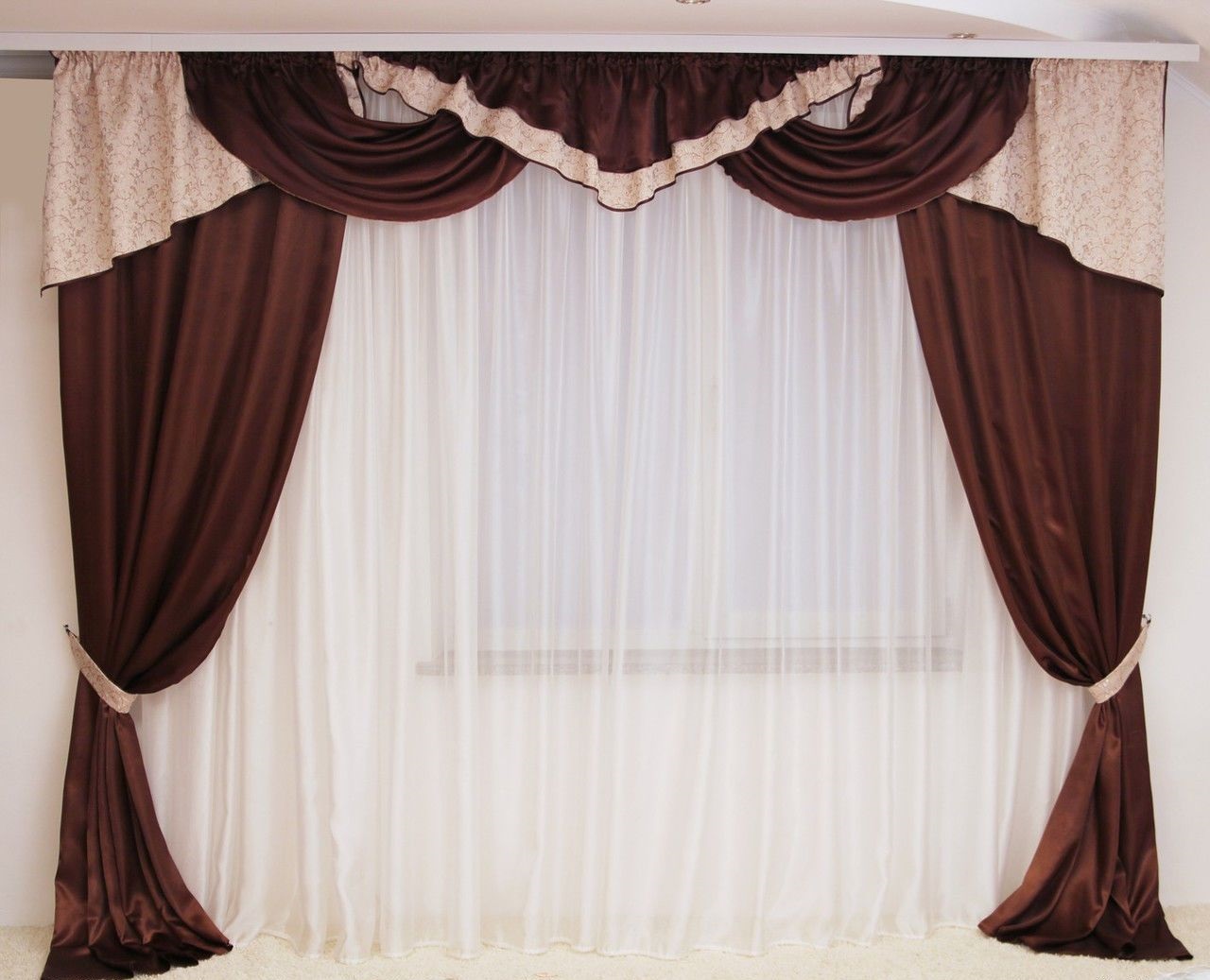
Hard
Thomas Chippendale is the man to whom we owe the appearance of the tough-looking lambrequins. Initially, antique items were made of wood. By the way, wood is still used in the production of lambrequins. Wooden lambrequins are a popular solution in the English and Russian style. But today, instead of wood, in the production of lambrequins, solid types of nonwoven fabrics and materials are used. This type of lambrequins is called "bando".
The advantage of rigid products in an unlimited choice of colors. They are often combined with blinds, since the density of both types of products is quite similar. The use of rigid lambrequins and combinations with curtains are shown in the photo.

Soft
From the name it is clear that the products are made of fabric. Depending on the design requirements, you can use lightweight, weightless materials, even tulle, as well as denser tapestry, brocade, velvet, and so on. The advantage of soft lambrequins is the variety of combination and design options. Such products are easier and more convenient to drape, to give them different shapes. And they look more home-like, unlike their harsh counterparts.
If you arrange folds in the form of puffs or scallops, lambrequins will give the room a rustic charm and comfort. You can see the options for using lambrequins made of woven materials in the photo gallery.

Openwork bando
If you want to give a special elegance, charm and sophistication to the design of the window opening, pay attention to the intricate openwork patterns. Modern technologies make it possible to produce complex, delicately executed openwork elements. Designers often use filigree bandos in their decoration. They serve more as a decorative element than a practical one. You can choose finished products from manufacturers, or you can order a product to your taste.
The main thing is that this decor element should correspond to the general style of interior decoration, especially the window.

Openwork bandos are curly and film. The former are complex designs. It usually consists of elements of different heights. Carved massive parts are usually placed on the sides. In the center there are narrow details that ensure maximum penetration of light into the room.

If a non-standard design solution has been chosen for the window decoration, you can use a film band. It consists of rolls with a pattern that is applied to the entire length of the product.
Advice. The film bando is often used as an independent detail in the design of a window opening. But it can also be used as a basis and, in some cases, part of a composition.

The following materials and fabrics are used for the manufacture of openwork bandos:
- Matte soft fabric with low pile.
- Chanselise is a fabric that has a glossy sheen.

Combined
Combined lambrequins are products that differ in the rigidity of the base and the softness of the fabrics used for drapery. Thanks to this versatile combination, they are in great demand. Such lambrequins are difficult to create with your own hands. For their manufacture, laser equipment is used, with the help of which it is possible to use more accurate and complex patterns with a wide number of options for patterns, patterns and ornaments.
Stylish and modern options for combined products are presented in the photo.

How to choose the right (material features)
When choosing such a window design element as a lambrequin, you need to pay attention not only to its color, but also such an important indicator as material. Curtain, tulle, curtain - the combination of materials from which the elements are made plays an important role. The fabric used in the production or sewing of the lambrequin must also correspond to the general stylistic direction of the room design. It is recommended to use the following types of fabrics for sewing hard garments:
- Brocade.
- Woolen.
- Taffeta.
- Atlas.
- Cotton.
- Velours.
- Brocade and other densely woven fabrics.

If, according to the design idea, lighter products are required, pay attention to the following options:
- Organza.
- Chiffon.
- Silk (natural or artificial).
- Linen, burlap (loose).
- Satin.
- Veil.
These delicate materials are not only pleasant to the touch, but also give the canvas "flowing" properties. The effect of lightness and sophistication is clearly demonstrated by the photos for the article.
Advice. If you decide to make a lambrequin yourself, use fabric glued with non-woven or dubrelin as a base. You can also use a thin layer of padding polyester. For openwork gangs, polyester materials or Velcro are suitable.

Application in the interior (photo and design selection)
Today in the field of design there are several areas that are most in demand:
- Modern.
- Classical.
- Minimalism.
- Rococo and Baroque, Empire.
Each of the directions dictates its own rules for the use of lambrequins in the design of window openings. Consider which ones are suitable for premises for different purposes.

To the living room
The living room is a room designed to receive guests. To make a good impression, you need to carefully approach the design of window openings, of which there are usually several in this room.
Styles Baroque, Rococo, Empire. If one of the named classic directions is used in interior decoration, more attention should be paid to lambrequins. Suitable for these styles will be curtain, heavy, dense fabrics, preferably light shades with a golden, shiny fringe. The advantage of lambrequins is a combination of soft and hard materials.

The practical high-tech style also makes special demands on lambrequins. Canvases made of soft or contrasting fabrics and colors are not welcome in this style. It is better to choose straight options that are similar in structure and color to the main canvas.

In minimalistic styles, for example, Japanese or Art Nouveau, you can use openwork bandos or lambrequins that correspond to the general design theme.
Retro, Boho and Shabby-chic styles allow the use of canvas with large or small flowers, puffs, application in the design of window openings.

For the hall
The purpose of this room is similar to the living room. But not so regulated. Numerous design options for window openings are shown in the photo.

To the nursery
When designing a window opening for a child's room, the child's preferences should be taken into account. As a rule, boys like topics related to their favorite characters, hobbies, sports or creative interests. If you and your child have not decided on the theme of the room decoration, choose neutral "cage", "strip", "graffiti".
If a small representative of the fair sex lives in the room, she will surely like lambrequins decorated with ruffle, braid, fringe in combination with tulle, organza, veil.

For bedroom
The purpose of the lambrequin in the bedroom is decorative and, if possible, protective. In this room, it is advisable to use combined options: a hard bando in combination with soft swagas will look aesthetically pleasing and protect the room from drafts during micro-ventilation. It is advisable to choose the color of the lambrequin that will overlap with the color of the curtains, bedspreads.

Advice. No more than 3 colors or shades - the main rule for choosing the color palette of fabrics used to decorate the window.
Drapery and decor
Lambrequins are attractive for their versatility in terms of drapery. You can see the options for draperies in the photo. We will give a few basic requirements for upholstery:
- Coquille. This option is suitable if moderate room lighting is required. In the middle of the window, folds are formed at an acute angle.Thus, the central part of the room is illuminated.
- Swagi. This option is a slack in the fabric. In this case, soft swags are formed. Ideal if you want to slightly dim the sunlight.
- Jabot (de jabot). Drapery is carried out on the sides of the window opening. The presence of numerous folds resembles a frill collar. Ideal for classic interiors.
- Crossover (semi-wag). A popular option for decorating not only home interiors, but also concert and museum halls.
- Tie. Not the most significant detail, but, nevertheless, giving a special sophistication to the design of the window opening.
- Cascade. This drapery option is used for items made from fabrics of contrasting colors.

How to hang (no curtains, one side, other ways)
We have already talked about the color and material of the lambrequins. Now let's talk about how to mount products:
- Lambrequin on one side. A great option for a double-leaf window! This method of designing a window opening can be used for a wider window opening, but then the canvas will sag almost half of the window. However, some design solutions allow for this option.
- For ceiling and regular cornices. In view of the peculiarities of this solution, hinges or rubberized eyelets should be used as fasteners. Plastic or metal rings are not the most suitable type of lambrequin suspension. In a strong draft, they disperse, disrupting the layout of the folds.
- Magnetic grips and clamps. Such elements provide a more reliable fixation of lambrequins.
- Braid and Velcro. These types of fasteners are mainly used not for frames, but for ceilings.

Common schemes, combinations and options for attaching lambrequins are shown in the photo.
Video: features of placing lambrequins in different rooms


